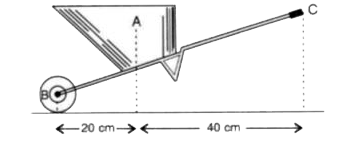Complete Solutions to EXERCISE-3(A) NUMERICALS of chapter MACHINES of Class 10 book with complete answers and questions
| Class 10 | PHYSICS |
| Chapter | MACHINES |
| SELINA PUBLICATION | EXERCISE-3(A) NUMERICALS |
| Number Of Questions | 12 |
| Academic Year | 2023-24 |
A crowbar of length 120 cm has its fulcrum situated at a distance of 20 cm from the load. Calculate the mechanical advantage of the crowbar.
01:13View SolutionA pair of scissors has its blades 15 cm long, while its handles are `7*5cm` long. What is its mechanical advantage ?
01:20View SolutionA force of 5 kgf is required to cut a metal sheet. A pair of shears used for cutting the metal sheet has its blades 5 cm long, while its handles are 10 cm long. What effort is needed to cut the sheet ?
01:56View SolutionFigure below shows a lever in use.

(a) To which class of lever does it belong ?
(b) If AB=1m, AF=0.4m, find its mechanical advantage.
(c) Calculate the value of E.02:24View SolutionA man uses a crowbar of length 1.5m to raise a load of 75 kgf by putting a sharp edge below the bar at a distance of 1 m from his hand. (a) draw a diagram of the arrangement showing the fulcrum (F), load (L) and effort (E) with their direction. (b) state the kind of lever. (c) Calculate : (i) load arm, (ii) effort arm, (iii) mechanical advantage, and (iv) the effort needed.
04:43View SolutionA pair of scissors is used to cut a piece of cloth by keeping it at a distance of 8.0 cm from its rivet and applying an effort of 10 kgf by fingers at a distance of 2.0 cm from the rivet.
(a) Find : (i) the mechanical advantage of the scissors, and (ii) the load offered by the cloth.
(b) How does the pair of scissors atc : as a force multiplier or as a speed multiplier ?02:54View SolutionA 4 m long rod of negligible weight is supported at a point 125 cm from its one end and a load of 18 kgf is suspened at a point 60 cm from the support on the shorter arm.
(a) If a weight W is placed at a distance 250 cm from the support on the longer arm to balance the rod, find W.
(b) If a weight 5 kgf is kept to balance the rod, find its position.
(c) To which class of lever does it belong ?
03:55View SolutionA lever of length 9 cm has its load arm 5 cm long and the effort arm is 9 cm long. (a) to which class does it belong ?
(b) Draw a diagram of the lever showing the position of the fulcrum F and directions of both the load L and effort E. (c) what is the mechanical advantage and velocity ratio if the efficiency is 100%?
(d) What will be the mechanical advantage and velocity ratio if the efficiency becomes 50%?05:18View SolutionFigure below shows a lever in use

(a) To which class of levers does it belongs ?
(b) Without changing the dimensions of the lever, if the load is shifted towards the fulcrum what happens to the mechanical advantage of the lever ?01:43View SolutionFigure below shows a wheel barrow of mass 15 kg carrying a load of 30 kgf with its centre of gravity at A. the points B and C are the centre of wheel and tip of the handle such that the horizontal distance AB=20 cm and AC=40 cm.

Find: (a) the load arm, (b) the effort arm,
(c) the mechanical advantage, and (d) the minimum effort required to keep the leg just off the ground.02:24View SolutionFigure below shoes the use of a lever.

(a) State the principle of moments as applied to the above lever.
(b) To which class of lever does it belong ? Give an example of this class of lever.
(c) If FA=10 cm, AB=490 cm, calculate: (i) the mechanical advantage, and (ii) the minimum effort required to lift and load (=50N).04:19View SolutionA fire tongs has its arms 20 cm long. It is used to lift a coal of weight 1.5 kgf by applying an effort at a distance of 15 cm from the fulcrum. Find : (i) the mechanical advantage of the togns, and (ii) the effort needed.
02:45View Solution
EXERCISE-3(A) NUMERICALS questions and complete solutions for chapter MACHINES of SELINA PHYSICS (ENGLISH) of Class 10
